
Credit: Dr. HAN Fangpu’s group
Dr. HAN Fangpu’s group from the Institute of Genetics and Developmental Biology of the Chinese Academy of Sciences reports the identification and functional study of the maize Knl1 gene in an article published online in PNAS. The gene is a major component of the KMN network that links centromeric DNA and the plus-ends of spindle microtubules. It also plays an important role in kinetochore protein recruitment.
The kinetochore complex that assembles on the centromeres mediates the proper partitioning of chromosomes to daughter cells during the cell cycle. However, kinetochore proteins undergo frequent mutations and coevolve with their interaction partners, leading to great diversity in kinetochore composition in eukaryotes.
Functional studies of kinetochore composition in plant model organisms are necessary to shed light on the evolutionary role of this intriguing component, and thus improve our collective understanding of the fundamentals of genetics.
The Knl1 is the constitutive component of the central kinetochore protein in plants. The researchers showed it was subcellularly localized and colocalized with other kinetochore components during interphase, mitosis, and meiosis. The functional importance of Knl1 in plants was demonstrated via characterization of the knl1 mutant.
The researchers revealed that Knl1 plays an essential role in chromosomal congregation and segregation during mitosis in maize, and deficiencies in Knl1 are linked to defective kernel development.
In addition, the researchers shed light on how spindle assembly checkpoint (SAC) proteins interact with kinetochores in plants.
In the present study, the scientists discovered that maize Knl1 interacts with BMF1/2 via a 145-aa region that does not contain well-known MELT repeats described in yeast and mammalian cells. This region displayed high divergence between monocots and eudicots, implying a rapid evolution of kinetochore proteins.
In fact, despite being evolutionarily conserved in function, KNL1 displayed low overall sequence similarity between species. The intricate species-dependent presence/absence of conserved sequence regions led the authors to propose an interaction network model of plant Knl1 with spindle assembly checkpoint signaling.
Understanding the evolutionary and functional importance of these fundamental individual components of the kinetochore complex may in turn improve the efficacy of downstream manipulations, such as the generation of haploid inducer lines for medical applications.
###
Media Contact
HAN Fangpu
[email protected]
Related Journal Article
http://dx.





